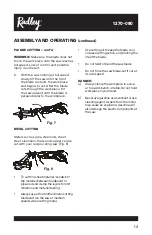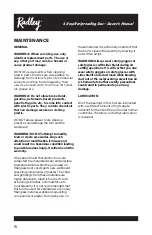
13
6 Amp Reciprocating Saw - Owner's Manual
WARNING:
For safety reasons, the operator must
read the sections of this Owner’s Manual
entitled "GENERAL SAFETY WARNINGS",
"POWER TOOL SAFETY", "SPECIFIC
SAFETY RULES", "EXTENSION CORD
SAFETY" and "SYMBOLS" before using
this reciprocating saw.
Verify the following every time the
reciprocating saw is used:
1. The correct blade for the material
being cut is installed in the saw.
2. The blade is firmly clamped in the
blade holder.
3. The blade is sharp and in good
condition.
4. The workpiece is properly secured.
5. Safety glasses and hearing protection
are being worn.
Failure to observe these safety rules will
significantly increase the risk of injury.
GENERAL CUTTING
1.
Clearly mark the workpiece to locate
the position of the cut.
2. Hold smaller workpieces with a
vice. Clamp larger workpieces to a
workbench or table.
DANGER:
Any workpiece that is not
adequately clamped in place may come
loose and cause serious injury. Never hold
the workpiece with your hand.
3. Make sure there are no nails, screws,
clamps or foreign materials in the path
of the saw blade.
4. Hold the saw away from your body and
in front of you (Fig. 6).
5. With both hands firmly gripping the
saw, and with the blade NOT in contact
with the surface to be cut, start the saw
by squeezing the switch trigger.
6. Once the saw has reached the desired
speed, place the adjustable pivoting
shoe against the workpiece and
gradually bring the moving blade into
contact with the workpiece at the
appropriate location.
CAUTION:
Do not force the saw. Use only
enough force to keep the blade cutting.
Excessive pressure on the blade will cause
it to bend and twist, which may result in
breaking the blade.
PLUNGE CUTTING
1.
Clearly mark the workpiece to locate
the position of the cut.
2. Clamp the workpiece to a workbench
or table (Fig. 7).
NOTE:
Make sure the area to be cut is clear
under the workpiece so that the blade will
not come into contact with anything other
than the workpiece.
3. Select a convenient starting point in the
area to be cut out. Place the tip of the
blade over that point.
4. Rest the lower edge of the adjustable
pivoting shoe on the workpiece
and hold it firmly in that position,
maintaining a shallow cutting angle.
5. Squeeze the switch trigger to start
the saw.
ASSEMBLY AND OPERATING
(continued)
Fig. 6






































